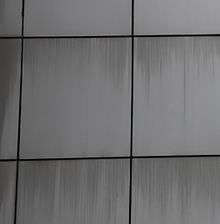Panel edge staining
Panel edge staining is a naturally occurring problem that occurs to anodized aluminium and stainless steel panelling and façades. It is semi-permanent staining that dulls the panel or façade's surface (in particular the edges of the panelling), reducing the natural lustre and shine produced by the anodizing processes used on the aluminium. Panel edge staining may also appear on powder coated aluminium, painted aluminium, stainless steel and titanium surfaces.

Causes
Panel edge staining is the by-product of the build-up of dirt and pollution. It is especially more noticeable on buildings using metallic façades in Asia, and regions close to the equator (such as Florida or South East Asia), as higher rates of air pollution,[1] high levels of humidity and consistent rainfall encourage panel edge staining to develop.
The unique top-to-bottom stain pattern of panel edge staining is caused when the build-up of dirt and pollution is washed from the higher panels to the lower panels of a surface by natural precipitation.[2][3]
Notes
- "Pollution in South East Asia".
- "Solid Aluminum Panels for Exterior Wall Cladding" (PDF). Retrieved August 30, 2012.
- "Rubbish removal". Archived from the original on 2018-08-15. Retrieved 2020-04-29. Tuesday, 25 July 2017
References
- Davis, Joseph R. (1999). Corrosion of Aluminum and Aluminum Alloys. ASM International. p. 197. ISBN 978-0-87170-629-4.
- Staining of facades By Michael Y. L. Chew, Tan Phay Ping
- Maintenance and Restoration of Architectural Aluminum By Service One, Inc. Technical Paper